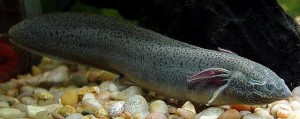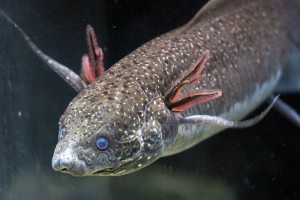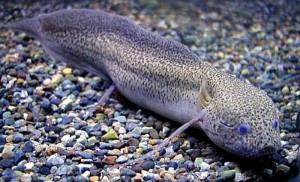The Gilled African lungfish (Protopterus amphibius) also known by tropical fish keeping enthusiasts as the East African Lungfish, is found in Kenya, Somalia, and Mozambique, East Africa and the delta of the Zambezi River.
Gilled African Lungfish are the smallest of the extant lungfish that seldom grow longer than 17 inches in length. Their bodies are a slate gray or a uniform blue color with a light pale gray belly and are covered with small inconspicuous black spots. All African Lungfish have soft scales, pelvic fins that look more like ropelike spaghetti appendages that they use to crawl around in the mud, and are eel like in appearance. Their dorsal, caudal, and tail fins are all fused to form a single fin like structure.
Like all African lungfish they posses two lungs (modified air bladders) which enable them to breathe air. They are actually a highly vascularized pocket of the digestive tract where gulped air is stored to oxygenate the blood that runs through the organ.
Their heart has also adapted to pump oxygenated and deoxygenated blood in separate streams to different parts of their body. This enables them to burrow into the mud and envelop themselves in a mucous cocoon during extended dry periods for months, to several years.
The process, known as estivation, allows the Gilled African Lungfish to lower it’s metabolic rate and survive severe droughts that normally deplete fish populations.
Gilled African Lungfish are found in swamps and flood plains where they can survive for months under the dried mud. They are dug up and eaten for food by some natives of the area, however they reportedly have a strong taste and are not widely enjoyed. The numbers lost to this practice are minimal.
Gilled African Lungfish are voracious eaters and their teeth are made for eating. Their upper jaw has two rounded teeth at the front, having a hard bridge that moves from side to side. Their lower jaw is equipped with numerous crushing teeth. The lungfish first sucks the prey into their mouth to thoroughly crush it, and then chews the broken carcass thoroughly until it is swallowed.
Because African Lungfish are highly aggressive carnivores, they are best kept in a single species aquarium. They are fearless and will attack any tankmate that moves in their vicinity. They should be housed in at least a 30 gallon aquarium with a mud, sand, or very fine gravel substrate, some aquatic plants and driftwood roots for them to hide among, and dimmed lighting.
Although they are not particularly sensitive to water quality and can survive in stagnant, abnormal aquatic conditions, they should still have a good canister filter to keep their tank water clear. Except when they need to surface to gulp oxygen from the atmosphere, they are mot very active and spend the time at the bottom of the aquarium.
The breeding season for Gilled African lungfish starts at the end of winter, which coincides with the beginning of the rainy season. They reproduce by laying eggs which are fertilized externally by the males. The males build a nest or “pit” in the mud and lines it with plants. After the females lay their eggs, the male will guard them and oxygenate them until they hatch.
The 3.5 to 4 millimeter diameter white colored eggs hatch in approximately one week. The tiny larvae look like tadpoles and have long, fan
like gills similar to newts that they initially use to breathe. For the first three weeks or so the male will continue guarding the fry. As the fry grow, they will undergo a metamorphosis of sorts that replaces their gills with openings that they will use to start breathing air into their lungs.
Gilled African Lungfish are highly versatile in their eating habits and will even eat dry food when trained to do so. They are carnivores that prefer eating small fish, shrimp, invertebrates, amphibians, crayfish, clams, worms, and anything they can fit into their mouths. When the food is too large for their mouths, they will nibble small pieces from it.
Gilled African Lungfish are rarely available to tropical fish keeping enthusiasts but can be “specialty ordered” online and from some specialty tropical fish shops.
Minimum Tank Size: 30 gallons
Care Level: Moderately Difficult
Temperament: Semi-Aggressive
Aquarium Hardiness: Moderately Hardy
Water Conditions: 77.0 to 86.0° F, 2 – 20 dGH, pH 6.0-8.0
Maximum Size: 17″
Color Form: Gray, Light Blue
Diet: Carnivore
Compatibility: Single Species Tank
Origin: Africa
Family: Protopteridae
Lifespan: 20-25 Years
Aquarist Experience Lever: Intermediate





